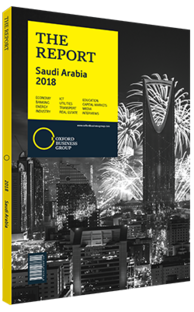Rollout of expanded broadband in Saudi Arabia progresses rapidly
With a land mass bigger than that of both Iran and Pakistan, Saudi Arabian telecoms firms intending to roll out infrastructure to the country’s widely distributed population face an expensive proposition. Rural areas, in particular, have historically represented a financially unattractive prospect, lacking the client base that would make large-scale investment worthwhile.
Consequently, while the Kingdom had achieved a mobile penetration rate of 190% by 2010, a study by global research firm Value Partners showed that fixed broadband penetration remained considerably below the average for developed nations, at 42%.
New Targets
The broadband market has progressed rapidly since then. According to the Communications and Information Technology Commission (CITC), some 3.25m people in Saudi Arabia had fixed broadband subscriptions in the second quarter of 2017, or 44.2% of households. The majority of customers – 1.56m people – were served by ADSL services, while 1m Saudi residents subscribed to fixed wireless platforms, and 690,000 people accessed fixed broadband through leased circuits and fibre-optic connections. However, most Saudis continue to access the internet through mobile broadband services. In the same quarter of 2017, mobile broadband density stood at 79.6% of the population, or 16.18m standard mobile data subscriptions.
Still, data patterns are changing rapidly due to the government’s decision to boost broadband coverage as part of its drive to support the non-oil economy. The recently formulated National Transformation Programme 2020 establishes a number of interim broadband targets to be met by that year. One of the most important is to “provide broadband services to all regions in the Kingdom by stimulating investment in infrastructure and developing tools, technical and regulatory frameworks”. More specifically, the government aims to link more than 80% of densely populated urban areas to fibre-to-the-home technology. Given that around 44% of urban areas had access to fibre services in 2016, this is an ambitious goal. The government’s strategy for rural areas, meanwhile, is based on wireless broadband technology, which it aims to extend to 70% of the non-urban population, up from 12% in 2016. Under an agreement with the government, STC is to contribute 60% of the required funding for the project, expected to cost SR7.3bn ($1.9bn) in total.
Progress Report
The drive to connect rural regions to better broadband services is already under way. In March 2017 the CITC announced that Zain Saudi Arabia would be awarded the first high-speed mobile broadband project for rural areas, serving more than 140,000 citizens in 13 provinces. In August 2017 the regulator stated that its mission to provide high-speed internet access to areas with low population densities was 50% complete, and ahead of schedule. According to the CITC, a total of 70,000 people across Riyadh, the Eastern Region, Al Jouf and the Northern Borders region had gained access to improved internet connections thanks to the broadband rollout. The advantages for the rural population are clear. Mobile broadband offers connection speeds up to 100 times faster than dial-up, and rural residents and businesses will find it much easier to access low-cost phone services via voice over internet protocol technology, as well as benefitting from always-on internet and less costly data.
Nevertheless, mobile broadband in other markets has often been seen as less preferable to fixed broadband, largely as a result of the higher cost of data and the greater frequency of data caps in mobile offerings. Saudi Arabia plans to offer quality services of both. “The Kingdom has one of the best mobile infrastructures in the world and huge potential for improving penetration of fixed broadband and fibre optics, driven by higher data consumption demand from individual consumers, families and enterprises,” Hu Xing, CEO of ZTE Saudi Arabia and vice-president of the Middle East division, told OBG. Consumers will likely keep an eye on the cost and service differential between the two technologies.
You have reached the limit of premium articles you can view for free.
Choose from the options below to purchase print or digital editions of our Reports. You can also purchase a website subscription giving you unlimited access to all of our Reports online for 12 months.
If you have already purchased this Report or have a website subscription, please login to continue.

